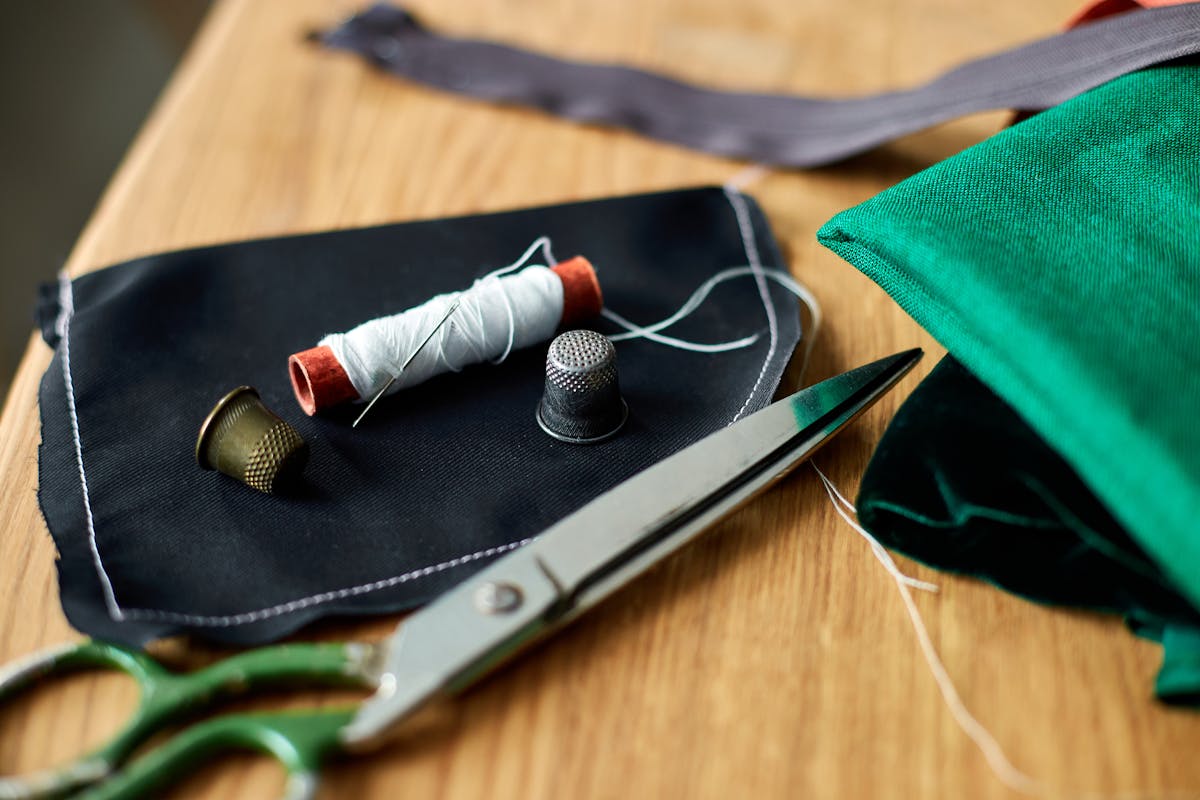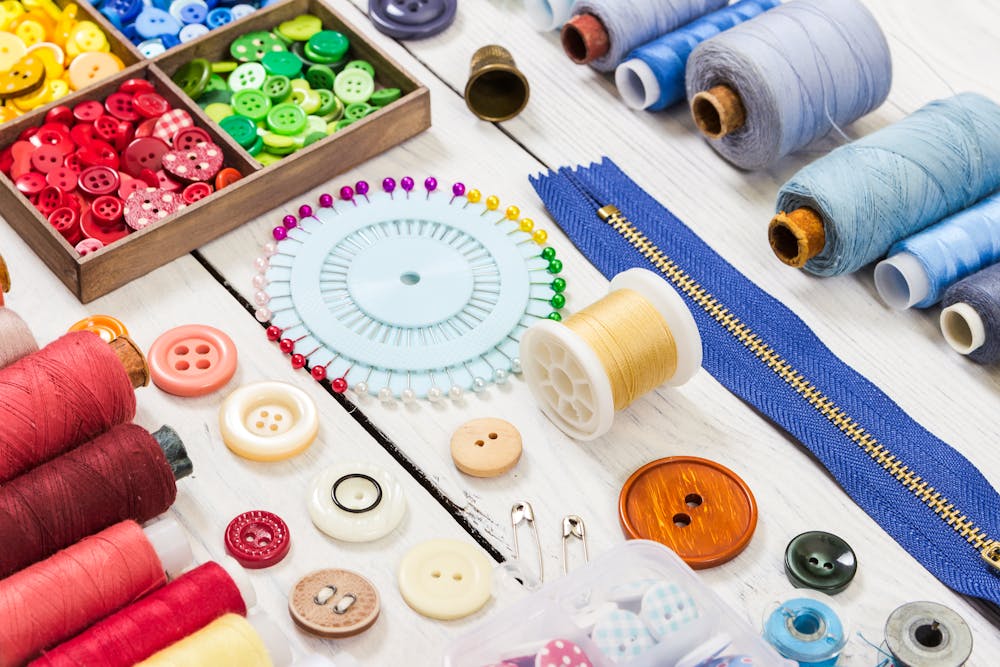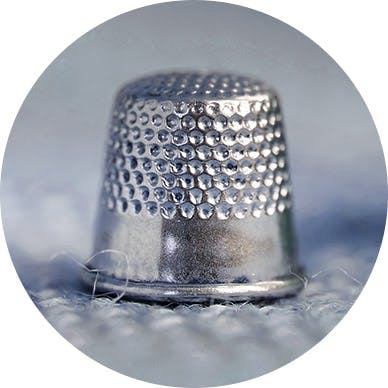As a custom clothing label company, we understand the importance of having the right tools for your sewing projects. Sewing tools not only make the process easier and more efficient, but they also help ensure the quality and professionalism of the final product. In this comprehensive guide, we will walk you through the basics of sewing tools, the different types available, advanced tools for specialized tasks, and maintenance and care tips.

The Basics of Sewing Tools
Before diving into the world of sewing tools, it's essential to familiarize yourself with the basics. From measuring tools to marking tools, each has a specific purpose and contributes to the overall success of your sewing project. Understanding how to use each tool correctly will help you achieve precise and well-executed stitches.
Let's start with measuring tools. One of the most commonly used measuring tools in sewing is the tape measure. This flexible tool allows you to accurately measure fabric, ensuring that your garment or project turns out the right size. Another useful measuring tool is the ruler, which is handy for straight lines and precise measurements.
Now, let's move on to marking tools. Marking tools are essential for transferring important information onto your fabric. One popular marking tool is the tailor's chalk, which is used to make temporary marks on fabric that can easily be brushed away. Another marking tool is the fabric marker, which leaves a permanent mark on the fabric and is ideal for long-term projects.
Importance of Proper Sewing Tools
Investing in proper sewing tools is crucial for achieving professional results. Not only do they offer durability and reliable performance, but they also save you time and frustration. Using high-quality needles, pins, and thimbles, among others, will ensure that your fabric is handled properly, reducing the risk of damage and resulting in a polished finished product.
Let's talk about needles. Needles come in various sizes and types, each designed for specific sewing tasks. For example, a universal needle is suitable for general sewing, while a ballpoint needle is ideal for knit fabrics. By using the right needle for your project, you can prevent skipped stitches and fabric damage.
Pins are another essential sewing tool. They are used to hold fabric pieces together before sewing. When choosing pins, opt for ones with sharp points and smooth heads to prevent snagging or damaging the fabric. Additionally, using a thimble can protect your finger from getting pricked while pushing the needle through thick layers of fabric.
Lastly, let's not forget about the importance of a good pair of scissors. Having sharp and precise scissors is essential for cutting fabric accurately. It's recommended to have a dedicated pair of fabric scissors to prevent them from dulling quickly. Additionally, investing in a pair of pinking shears can help prevent fabric fraying.

Comprehensive Guide to Different Types of Sewing Tools
Sewing is a craft that requires precision, attention to detail, and the right tools. In this comprehensive guide, we will explore the various types of sewing tools that are essential for every sewing enthusiast. From needles and pins to measuring tools and marking tools, each tool plays a crucial role in ensuring the success of your sewing projects.
Needles and Pins: The Backbone of Sewing
When it comes to sewing, needles and pins are the unsung heroes. Needles are available in various sizes and types, each serving a specific purpose. From universal needles for general sewing to specialized needles for specific fabrics like leather or knits, choosing the right needle is crucial for achieving clean and even stitches. The size of the needle determines the size of the stitch, while the type of needle ensures that the fabric is not damaged during the sewing process.
Pins, on the other hand, help hold your fabric in place, preventing shifting and ensuring accurate sewing. There are different types of pins available, including glass head pins, ballpoint pins for knits, and silk pins for delicate fabrics. Using the right pins for your project will make a significant difference in the overall outcome of your sewing.
Thimbles, Threaders, and Trimmers: The Essential Trio
Thimbles, threaders, and trimmers are three essential tools that contribute to the overall ease and efficiency of your sewing process. Thimbles are worn on the finger to protect it while pushing needles through thick layers of fabric. They provide a barrier between the needle and your skin, preventing any accidental pricks or injuries.
Threaders, as the name suggests, help guide the thread through the eye of the needle. They are especially useful for individuals with poor eyesight or when working with fine threads. Threaders come in various designs, including wire loop threaders and automatic threaders, catering to different needs and preferences.
Trimmers ensure that excess thread is neatly trimmed away, giving your sewing projects a professional finish. They come in different forms, such as small scissors or thread snips, and are designed to reach tight spaces easily and cut threads without damaging the fabric.
Measuring Tools: Ensuring Precision in Sewing
Accurate measurements are crucial for achieving well-fitted garments or perfectly aligned seams. Measuring tools such as tape measures, rulers, and French curves provide the necessary precision to ensure your project's success. Tape measures are flexible and can be wrapped around the body or fabric, allowing you to take accurate measurements. Rulers, on the other hand, are ideal for measuring straight lines and ensuring even seam allowances.
French curves are essential for creating smooth and flowing lines, especially when working with patterns or making alterations. They are curved rulers that come in various shapes and sizes, allowing you to easily trace and create curves that fit your desired design.
Marking Tools: The Blueprint of Your Sewing Project
Marking tools play a vital role in transferring important design elements and guidelines onto your fabric. Whether it's marking darts, pleats, buttonholes, or pattern notches, using the correct marking tool is essential. Chalk wheels and tailor's chalk are commonly used for marking fabric, as they provide clear and temporary marks that can be easily removed.
For more delicate fabrics or when permanent marks are required, washable markers and tracing paper can be used. Washable markers come in various colors and are designed to disappear with water or after a certain period of time. Tracing paper, on the other hand, allows you to transfer markings onto the fabric by placing it underneath and tracing over the lines with a tracing wheel.
By understanding the different types of sewing tools and their specific uses, you can enhance your sewing skills and achieve professional results. Whether you're a beginner or an experienced sewist, investing in high-quality tools and using them correctly will make a significant difference in the outcome of your sewing projects.

Advanced Sewing Tools for Specialized Tasks
Are you ready to take your sewing skills to the next level? If so, then it's time to explore the world of advanced sewing tools. These tools can help you achieve professional-looking results and add a polished touch to your sewing projects. In this article, we will discuss three essential tools that every advanced sewer should consider: serger machines, embroidery hoops, and a good sewing machine.
Understanding Serger Machines
When it comes to creating neat and durable finished edges, serger machines are a game-changer. These machines are perfect for projects that require professional-looking seams, such as custom clothing labels and hang tags. With their ability to trim, sew, and finish edges in one pass, serger machines simplify the sewing process and add a polished touch to your garments. Imagine the satisfaction of seeing perfectly finished edges on your creations!
But how do serger machines work? Well, they use multiple threads to create a strong and secure seam. These machines have built-in knives that trim the fabric as it is being sewn, ensuring that the edges are clean and neat. The result is a professional-looking finish that will impress even the most discerning eye. So, if you're serious about taking your sewing skills to the next level, investing in a serger machine is definitely worth considering.
The Role of Embroidery Hoops
If you're interested in adding decorative embroidery to your sewing projects, an embroidery hoop is an essential tool. Embroidery hoops hold your fabric taut, ensuring smooth stitching and preventing puckering or distortion. Whether you're embroidering intricate designs or adding personalized details to your clothing labels and hang tags, an embroidery hoop will help you achieve precise and professional results.
Embroidery hoops come in various sizes and shapes to accommodate different project needs. They are typically made of wood or plastic and consist of an inner and outer ring that can be tightened to secure the fabric. By keeping the fabric taut, the embroidery hoop ensures that your stitches are even and consistent, resulting in a beautiful finished product. So, if you're ready to add a touch of elegance and sophistication to your sewing projects, make sure to invest in a quality embroidery hoop.
The Power of a Good Sewing Machine
A reliable sewing machine is undoubtedly the backbone of any sewing setup. From basic stitches to advanced features like buttonholers and zigzag capabilities, a good sewing machine can handle a wide range of projects. When purchasing a sewing machine, consider your sewing needs and look for models that offer durability, ease of use, and versatility.
With the right sewing machine, you'll be able to tackle various sewing tasks, including creating custom clothing labels and hang tags. Imagine the convenience of having a machine that can handle different fabrics, stitch types, and even embroidery designs. Whether you're a beginner or an experienced sewer, a good sewing machine will be your trusted companion throughout your sewing journey.
When shopping for a sewing machine, it's important to do your research and read reviews from other sewers. Look for a machine that has a solid construction, various stitch options, and user-friendly features. Additionally, consider the warranty and customer support offered by the manufacturer. By investing in a good sewing machine, you'll be setting yourself up for success and endless sewing possibilities.
In conclusion, advanced sewing tools can elevate your sewing projects to new heights. Whether you're looking for neat and durable finished edges, precise embroidery, or versatile sewing capabilities, serger machines, embroidery hoops, and a good sewing machine are essential tools to consider. So, what are you waiting for? Start exploring these tools and take your sewing skills to the next level!

Maintenance and Care for Your Sewing Tools
When it comes to sewing, proper maintenance and care for your tools are crucial for ensuring their longevity and optimal performance. Cleaning and storing your sewing tools correctly can make a significant difference in their lifespan.
After each use, it is essential to remove any thread or fabric residue from your tools. This step helps prevent buildup and keeps your tools in excellent condition. You can use a small brush or a lint roller to remove any debris. Pay extra attention to areas where thread tends to get tangled, such as the bobbin case of your sewing machine.
Once your tools are clean, it's time to store them properly. Find a clean and dry environment to keep your tools. Avoid storing them in humid areas, as moisture can cause rust or damage to certain materials. Consider using storage containers or cases specifically designed for sewing tools to keep them organized and protected.
While cleaning and storing your tools are essential, don't forget about maintaining your sewing machine. Regularly oiling and lubricating your machine will help keep it running smoothly and extend its lifespan. Consult your sewing machine's manual for specific instructions on how often and where to apply oil.
When and How to Replace Sewing Tools
Even with proper care, sewing tools can wear out over time. It's crucial to know when to replace certain tools to avoid frustration and potential fabric damage during your sewing projects.
One of the most common tools that needs regular replacement is the sewing machine needle. Needles can become dull or bent after extended use, leading to skipped stitches or fabric damage. Inspect your needle regularly and replace it as soon as you notice any signs of wear.
Pins and scissors are also tools that may require replacement. Bent or blunt pins can damage your fabric or make it challenging to sew accurately. Similarly, dull scissors can result in uneven cuts and frayed edges. Invest in high-quality replacements to ensure precise and professional results.
Furthermore, specialized tools like serger machines and embroidery hoops may also need replacement or maintenance. These tools have specific mechanisms that can wear out over time. Consult the user manual or contact the manufacturer for guidance on when and how to service or replace these tools.
In conclusion, taking care of your sewing tools is essential for successful sewing projects. By cleaning and storing your tools properly and knowing when to replace them, you can ensure their longevity and maintain the quality of your sewing endeavors. So, invest in high-quality tools, practice regular maintenance, and enjoy creating beautiful garments, including custom clothing labels and hang tags, with precision and professionalism.













